History of Seville 5. The 16th century, the “Golden Age”
Seville 16th century. The date is August 13, 1568, and a colossal 4-meter bronze sculpture was placed with great effort at the top of the main tower. It is a female figure that represents the Triumph of the Catholic Faith. She carries a palm in her right hand and a banner in her left. Cervantes will call her La Giganta (The Giant) of Seville. It is also a weather-vane, so at a height of 100 meters she can see the entire city and what happens in its most remote corners. Let’s imagine what she sees:
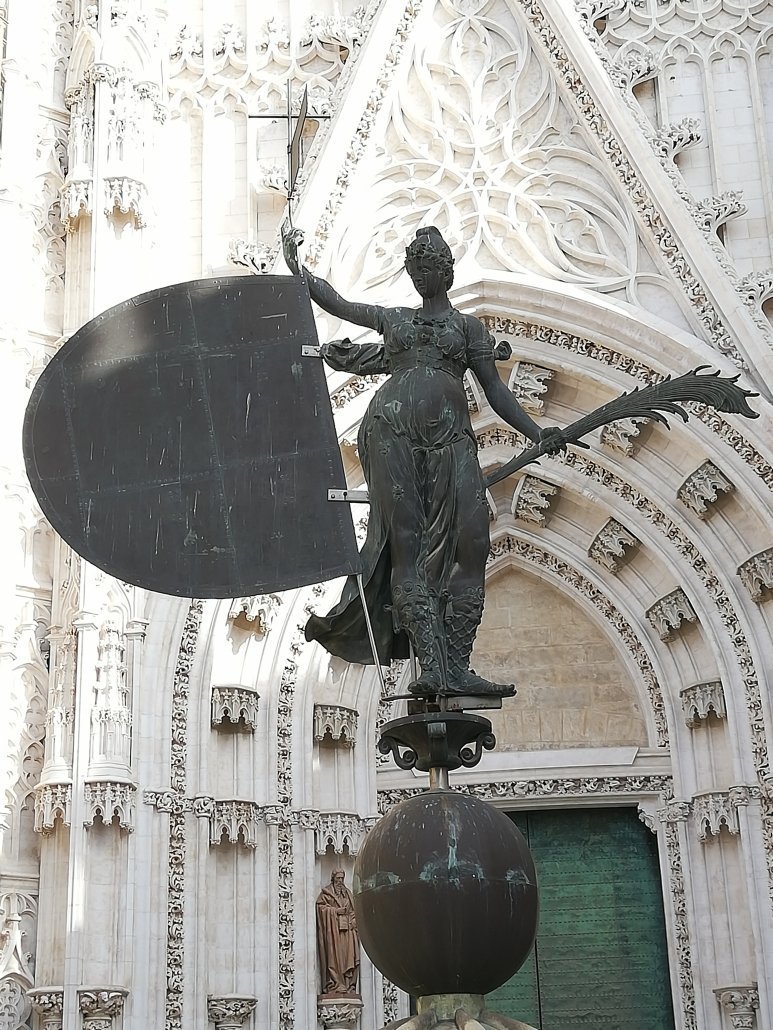
Neighbourghoods in Seville in the 16th century
The Guadalquivir river receives annually the Fleet of Indies from New Spain, today Mexico and from Tierra Firme, Peru. In this Seville of the 16th century the caravels take three months to arrive from America and around three days with luck to go up the river with the help of the wind and the tides. They dock at the Torre del Oro (Tower of Gold) and flood the city of silver, which, crossing the Postigo del Carbón, a small door in the wall, becomes hard cash in the nearby Casa de la Moneda (the Mint), a factory and citadel between the river and the Royal Palace, which is the envy of all the cities of Spain.
The Arenal neighborhood is developed at this time, with its shipyards to repair ships, its incessant activity of coopers, blacksmiths, rope makers, fish warehouses and the Malbaratillo mount, a kind of flea market where everything is bought and sold. But also the suburb of Triana with its sinister castle of San Jorge at the entrance, seat of the Holy Inquisition. Triana is a boiling neighborhood, especially of sailors and potters who use the clay from the banks of the river to make pottery, ceramic bowls, pots..
An Italian named Niculoso Pisano arrived in Triana in 1555 and revolutionized the ceramic technique with a technique for painting on flat tile. Until then it was only made in the Arab way, tiled type or with that relief that had the function of separating the colors. Since Micer Nicolas arrived in Seville with his new idea, the motifs and drawings of our beautiful ceramics have been multiplied.
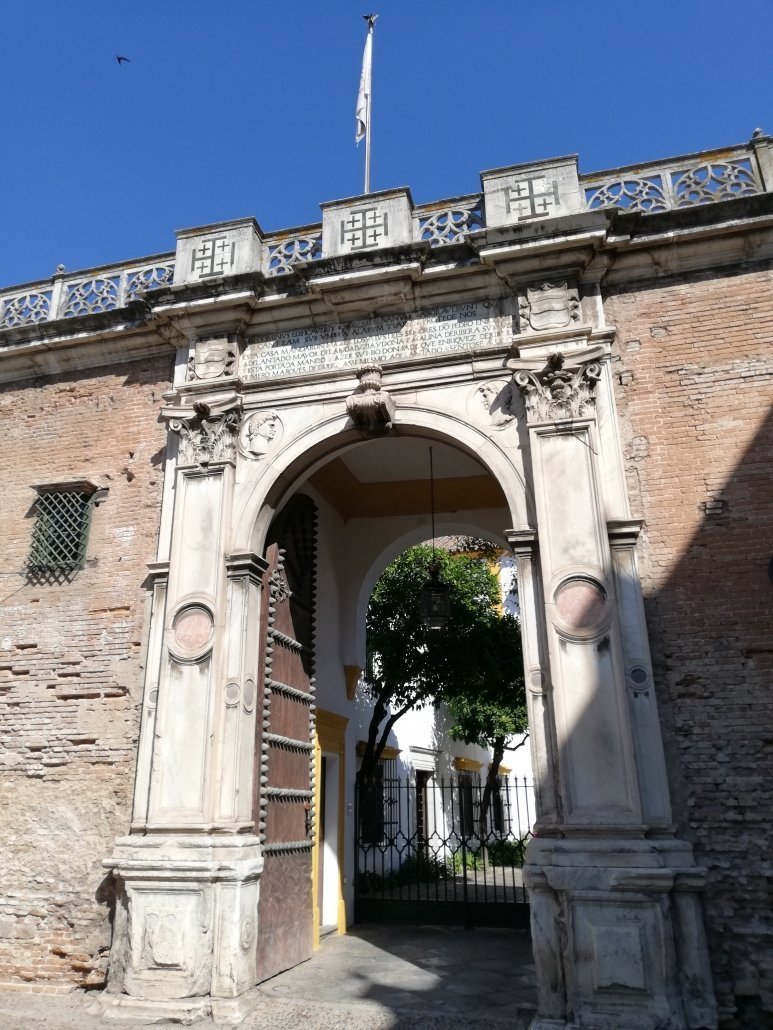
Seville is not the capital of the kingdom, but because of its cultural splendor it is already called the New Rome. And in its beautiful palaces such as the Casa Pinelo, the Dueñas Palace and the Casa de Pilatos, the Sevillian aristocracy is dedicated to collecting antiques, works of Charity and literary and artistic gatherings.
Churches and Palace in the Renaissance time
Churches and palaces proliferate in Seville in the 16th century but the great Cathedral, recently inaugurated in 1507, stands out naturally and can boast of being one of the largest in the world. This Gothic temple built almost everything throughout the 15th century does not want to do without the new airs that come from Italy.
The Main Sacristy and the surprising Chapter House will be made under the trendy Renaissance style. This Chapter house is a meeting room and his architect has had the brilliant idea to make it elliptical, thus providing exceptional acoustics. He was Hernán Ruiz from Cordoba, also the author of the upper part of the belltower.
There 24 bells, each dedicated to a saint, jugs of lilies in the corners representing the purity of the Immaculate Conception and me myself, stand above as an exceptional witness, like a victorious triumph in these religious struggles that sadly flooded Europe for years.
The Muslim and Hebrew have left our lands for years, but Catholicism from Rome and with Spain as its main champion, has a new enemy, Protestantism.
And to combat it the Catholics dedicate all their efforts, from the almighty Holy Inquisition that watches over every movement, to the artists, who began to decorate more and more churches with religious figures, to convince a people that they are the true Faith. Among these artists that spread the faith with their beautiful images of saints and virgins we have to mention Alejo Fernandez, Luis de Vargas, Pedro de Campaña, Hernando de Esturmio and Pedro de Villegas Marmolejo.
Merchants, printers and book collectors in the 16th century
In the city of Seville in the 16th century there is a big number of foreigners, they came from Flanders and other places in northern Europe attracted by the wealth of Seville and the offer of artistic works in the city. Not only painters and sculptors, also in these years Seville is full of merchants.
The streets that surround the Cathedral are a reminder of its origins as Alemanes, Francos or Placentines street (from Plasencia). And the printing press could not be missing, the most famous in Seville owned by the German Cromberger.
Surely one of his clients was the contemporary Hernando Colon, son of the discoverer Christopher Columbus and one of the most educated men in Europe, who had a magnificent library of 40.000 volumes. It would later be called the Columbine library that is still preserved in the Cathedral of Seville.
The House of the Trade
The monopoly of the Indies from Seville in the 16th century is not nonsense. The Casa de Contratación (House of Trade) founded by Queen Isabela in 1503 is the one that makes all the decisions regarding the newly discovered continent. It will have to take care of collecting the real fifth (taxes) of all commercial transactions, it will have to give the permits to go to the New World, it will have to organize the nautical studies and she will also organize all the exploration expeditions beyond the ocean.
Its maximum position is the Piloto Mayor(Chief Pilot). By the way, an Italian named Americo Vespucci, navigator and cartographer, held this position from 1508 to 1512. With time and with some luck, he will have the honor of having the new continent be named after him: America.
The first trip around the World
But undoubtedly one of the greatest achievements of the Casa de Contratación of Seville in the 16th century is having organized the expedition of a Portuguese, Ferdinand Magellan. His adventure began in Seville as captain in command of 5 ships to search for the coveted spices in the antipodes of Spain, ended gloriously three years later after having made the first round the world. However, Magellan, its captain, perished in Mactan (Philippines) and the 18 survivors barely returned to Seville in 1522 aboard the Victoria and under the command of Juan Sebastian Elcano. It can be said without doubt that it was the greatest maritime feat of the 16th century.
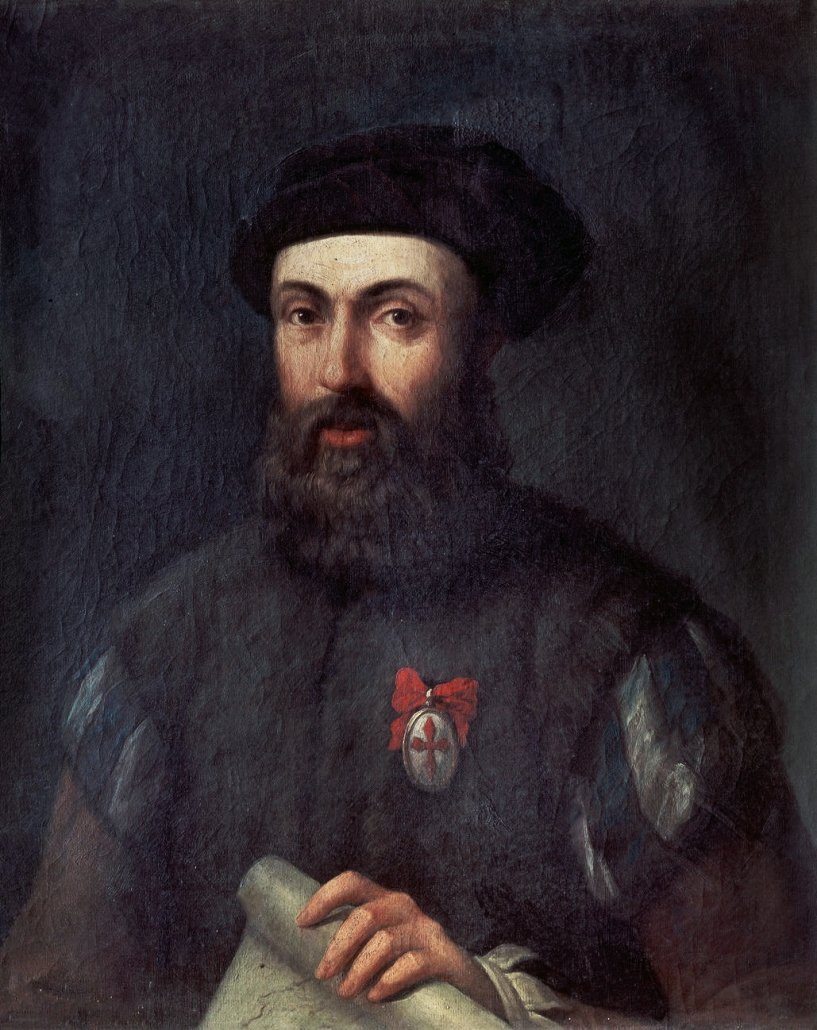
That city of Seville in the 16th century had 150,000 inhabitants.
This Seville of lights, culture and wealth also had its dark side, where most of the Sevillians were crowded in unsanitary conditions within a wall built in Islamic times and that if it was still preserved it was to protect the city from the feared epidemics and from the frequent floods of the Guadalquivir.
The river entered the city through various areas, the main one being the Alameda, an authentic lagoon, so that at the end of the 16th century the Count of Barajas ordered it to be drained and the first public garden in Europe to be built there. That didn’t stop the floods from hitting the city every few years.
It was a city in which rogues and thugs abounded, such as Cervantes in his famous novel Rinconete and Cortadillo. Names that have become part of universal literature.
In fact, our most famous Spanish writer, Cervantes, knew Seville in the 16th century first-hand. He was in the city with the intention of going to the Indies but did not obtain the corresponding permission, who knows if Don Quixote would have been written if he had obtained authorization from the Casa de la Contratación. He stayed in Seville, and he had time to write about the rogues of the city, to praise the figure of the Giralda and the beautiful sculpture that crowned it and to temporarily go to jail because of a murky matter while he was a tax collector.
This so-called royal prison where Cervantes was hosted was located at the beginning of Sierpes street, already then the main commercial thoroughfare in Seville. A few meters away was the newly built convent of San Francisco, today the Town hall, where Diego de Riaño carved the beautiful facade in the Plateresque style, fine work more typical of goldsmiths and silversmiths than stone artists.
That was the most important square in the city and there were held from bullfights to public trials, both with great success from the public always eager for news and parties.
The other great celebration loved by the people was the theater, but this took place in specific places, called “corrales de comedias”. There was throughout the city, the Corral de Doña Elvira, the Corral del Conde, the Coliseum, in the same area of the Alcazar. There were puritanical voices against the theater as amoral and social agitator, but they could never eradicate it due to the enormous popular support. Cervantes, Lope de Rueda and other famous playwrights premiered their works in Seville.
Royal Weddings in Seville
But without a doubt the great spectacle of the century was the wedding of Emperor Charles, who chose Seville to marry in 1526.
His fiancée was Isabel de Portugal, a carnal cousin, so they had to have a special dispensation from the pope to celebrate the union. As usual it was an arranged marriage but the romantic legend of Seville wanted it to be love at first sight the moment they met. They did it the day before the wedding in the Royal Alcázares and according to what the emperor could not wait for the next day and called the archbishop who was already in bed to immediately marry them in private and thus sanctify their union.
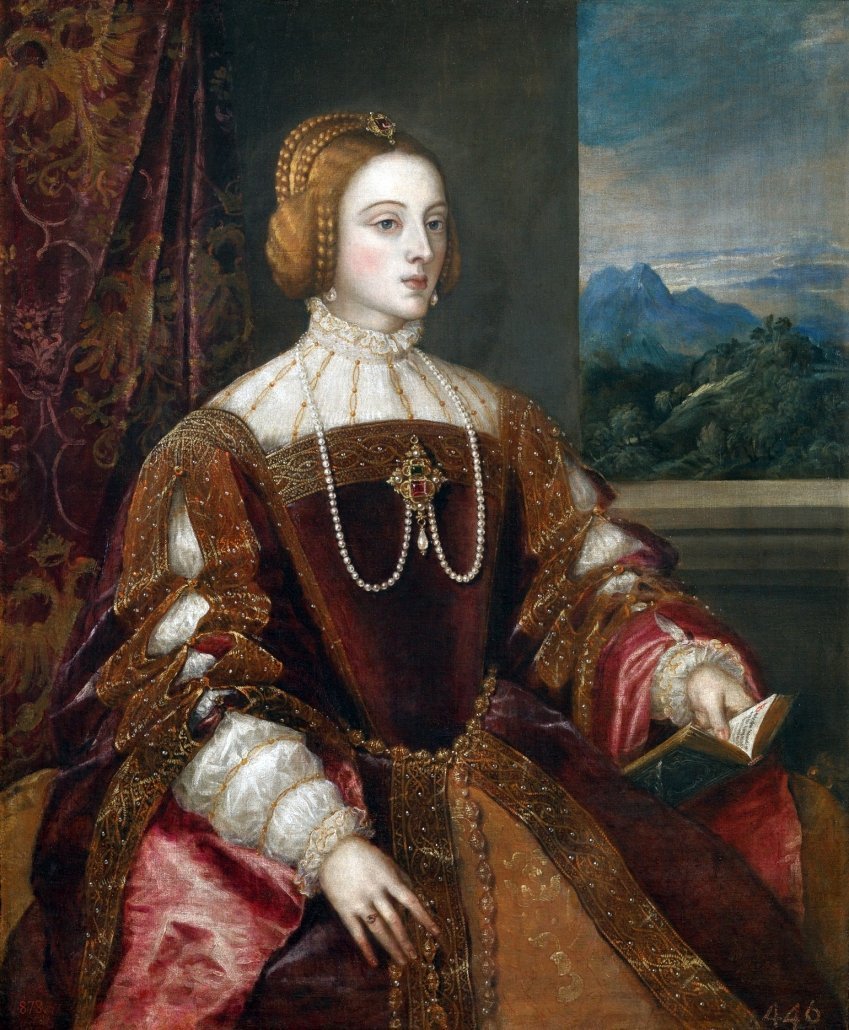
The Alcazar gardens that we have today are largely the product of that great celebration. Years later, their son, King Felipe II, ordered the decoration of the Alcazar Banquet Hall, where the banquet had been held, with these beautiful tiles by Cristobal de Augusta in homage to the marriage of the emperor and the empress.
Seville was the de facto capital of an empire in which the sun did not set, the European and American possessions were completed with the Philippines on the other side of the world and from 1580 to 1640 also Portugal, which was incorporated by inheritance into the dominions of Philip II and which regained its independence in the mid-17th century.
But that splendid 16th century Seville was largely a mirage. The successive bankruptcies of the crown, the decline of the American metal and the famines and floods plunged Seville into an almost endemic crisis.
However, the artistic seed planted in the XVI century took root and despite the difficulties, the XVII century would be one of great splendor for art and culture, the so-called Siglo de Oro (Gold Century).
Meanwhile I invite you to have a look to our tours in Seville that will bring to this Seville in the 16th century. https://www.toursevilla.com/tours/
You can learn more about Ferdinand Columbus in this article and video published in my blog https://www.toursevilla.com/en/hernando-colon-el-hombre-que-amaba-los-libros/
Don’t worry to know more about the outstanding women of Seville in the 16th like Catalina de Ribera. Here there is a video (spanish) https://youtu.be/Dj2O0PceHlo

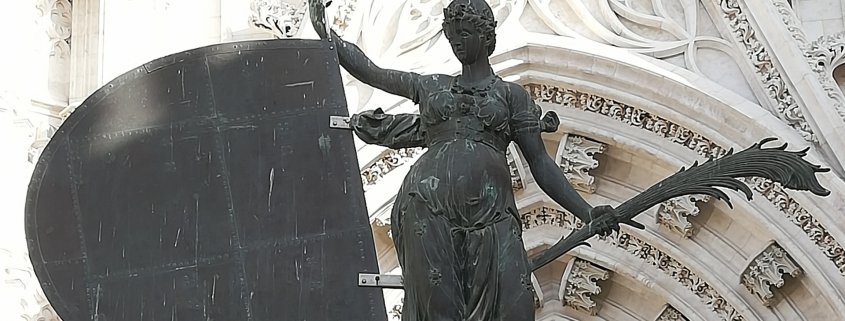
 Toursevilla
Toursevilla Toursevilla
Toursevilla